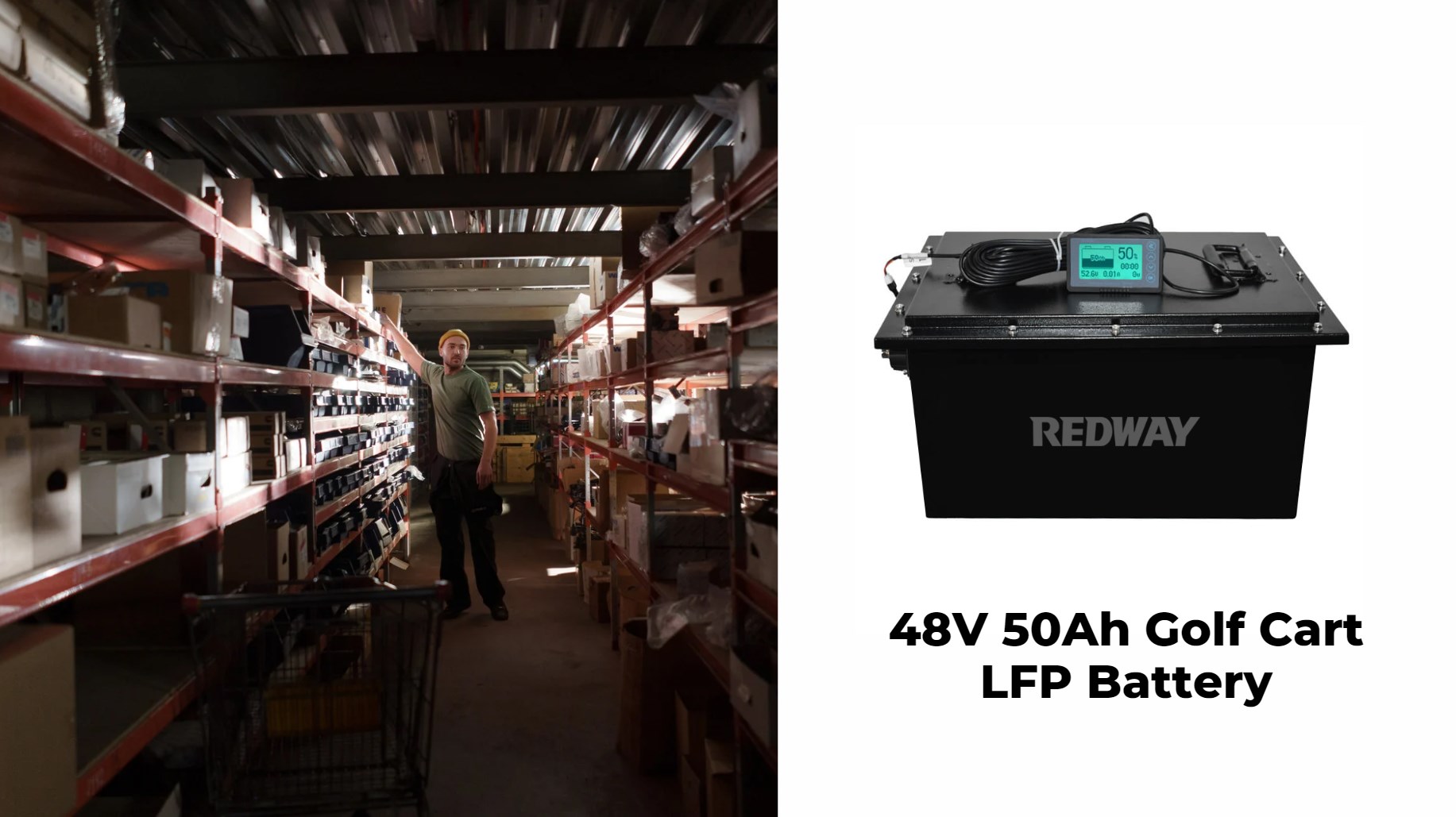As the demand for Lithium Iron Phosphate (LiFePO4) batteries grows, particularly for applications like golf carts, understanding the proper storage conditions for these batteries becomes crucial. At Redway Battery, with over 12 years of experience in manufacturing high-quality LiFePO4 batteries, we recognize that the way these batteries are stored can significantly impact their performance, lifespan, and overall safety. This article outlines the essential considerations for storing LiFePO4 golf cart batteries effectively.
1. Optimal Storage Environment
Temperature Control
The ideal storage temperature for LiFePO4 batteries typically ranges from 32°F to 95°F (0°C to 35°C). Storing them in environments that exceed this temperature range can lead to reduced battery performance and lifespan. Extreme temperatures, especially heat, can accelerate chemical reactions within the battery, potentially causing damage or diminishing capacity.
Avoiding Temperature Extremes
- Hot Climates: If you are in a region with high temperatures, consider air-conditioned storage or insulated containers to maintain a stable temperature.
- Cold Climates: While LiFePO4 batteries perform better in cold conditions compared to other lithium batteries, extremely low temperatures can still affect performance. Avoid storing below -4°F (-20°C).
Humidity Levels
High humidity can promote corrosion and other forms of deterioration. Aim for a relative humidity level of around 30% to 50%. Using a dehumidifier in storage areas can help maintain these levels.
2. Battery Charge Levels During Storage
Optimal State of Charge (SoC)
When storing LiFePO4 batteries, it’s essential to maintain an optimal State of Charge (SoC). Ideally, batteries should be stored at about 50% to 70% charged. Storing at this charge level helps in prolonging the lifespan of the battery and minimizes the risk of cell degradation.
Regular Monitoring
Regularly check the charge level, especially if the batteries are stored for extended periods. If the charge drops below 30%, it is advisable to recharge the batteries to prevent deep discharge, which can lead to capacity loss and potential damage.
3. Physical Placement and Safety
Avoiding Damage
When storing LiFePO4 batteries, ensure they are placed on stable, non-conductive surfaces. Avoid stacking batteries, as this can lead to physical damage and short-circuit risks. Ensure that there is sufficient space around each battery for ventilation.
Safety Precautions
Always store batteries away from flammable materials and in a well-ventilated area. This is crucial for preventing any potential hazards associated with battery leaks or failures.
4. Maintenance Considerations
Regular Inspections
Periodically inspect stored batteries for signs of damage, leakage, or corrosion. Look for physical deformities, which could indicate internal issues. Regular maintenance helps identify problems early, ensuring safety and performance.
Cleaning Connections
Keep battery terminals and connections clean. Dust and grime can lead to increased resistance and reduced performance. Use a dry cloth or a mixture of baking soda and water to clean terminals, ensuring they are completely dry before reassembling.
5. Documentation and Tracking
Record-Keeping
Maintaining a record of the storage conditions and charge levels can aid in ensuring optimal performance. Document the dates of charging, inspections, and any maintenance performed. This information is valuable for assessing battery health over time.
Manufacturer Guidelines
Always refer to the manufacturer’s guidelines for specific storage recommendations. At Redway Battery, we provide detailed instructions tailored to our LiFePO4 golf cart batteries, ensuring that users can optimize their performance and lifespan.
6. Seasonal Considerations
Winter Storage
If storing batteries for winter, consider the following:
- Keep Batteries Charged: Before storing, ensure they are charged to about 50% to 70%.
- Insulate: For prolonged winter storage, consider wrapping batteries in thermal insulation to mitigate temperature extremes.
- Location: Store batteries indoors, away from extreme cold, ensuring they are in a stable environment.
Summer Storage
During the summer months, the emphasis should be on maintaining cool storage conditions. Use reflective covers or insulated boxes to help control temperature and humidity levels.
7. Conclusion: Best Practices for Storing LiFePO4 Golf Cart Batteries
Storing LiFePO4 golf cart batteries properly is crucial for ensuring their longevity, performance, and safety. By adhering to the optimal storage conditions outlined above—maintaining appropriate temperature and humidity levels, monitoring state of charge, and performing regular inspections—users can significantly enhance the lifespan and reliability of their batteries.
At Redway Battery, we pride ourselves on delivering high-quality, customized lithium battery solutions. If you’re looking for expert advice or specific products tailored to your needs, contact us today for a quick quote. Proper storage of LiFePO4 batteries not only safeguards your investment but also contributes to a more sustainable and efficient energy future.
Latest News
- Storage Guidelines: Recent articles emphasize best practices for storing LiFePO4 golf cart batteries to ensure longevity and optimal performance.
- Temperature Control: Recommendations include maintaining moderate temperatures and avoiding extreme conditions during storage periods.
- Battery Maintenance Tips: Regular checks on charge levels are advised to prevent deep discharge scenarios that could damage the battery.
Redway Expert Comment
Proper storage of LiFePO4 golf cart batteries is crucial for maximizing their lifespan and performance. Maintaining moderate temperatures during storage helps prevent degradation, while regular monitoring of charge levels ensures they remain within safe limits. As an expert in lithium technologies, I recommend following these guidelines closely to ensure reliable performance when the batteries are put back into use.
FAQs
What are the best practices for storing LiFePO4 batteries indoors?
Store LiFePO4 batteries in a cool, dry place with temperatures between 15°C and 25°C (59°F and 77°F). Ensure low humidity to prevent moisture buildup. Disconnect all loads and store at a charge level between 50% and 80%. Use non-conductive containers to avoid short circuits and periodically check the battery’s condition.How often should I cycle LiFePO4 batteries during long-term storage?
It is recommended to cycle LiFePO4 batteries at least once every six months during long-term storage. This helps maintain battery health and ensures that the charge level remains within the optimal range of 50% to 80%, preventing capacity loss.What is the ideal state of charge for storing LiFePO4 batteries?
The ideal state of charge for storing LiFePO4 batteries is between 50% and 80%. Storing them fully charged or completely discharged can stress the battery and lead to reduced capacity over time, making it essential to maintain this mid-level charge.How does extreme temperature affect the longevity of LiFePO4 batteries?
Extreme temperatures can significantly impact the longevity of LiFePO4 batteries. High temperatures accelerate chemical reactions, leading to faster degradation, while very low temperatures can cause electrolyte freezing, damaging internal structures. Ideally, store batteries within the recommended temperature range to maximize lifespan.What precautions should I take to prevent battery damage during storage?
To prevent battery damage during storage, ensure that the batteries are clean and dry before storing. Disconnect all loads, keep them in a stable temperature environment, and avoid areas with high humidity or extreme temperatures. Regularly check for signs of damage, such as swelling or leaks, and maintain an optimal charge level.





